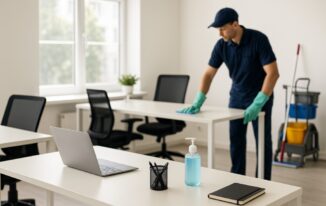Creating a safe and welcoming environment for both customers and employees is crucial for any business. Not only does it promote a sense of trust and reliability, but it also minimizes risks and ensures that your business operates smoothly. Whether you run a retail store, office, or industrial facility, prioritizing safety should always be at the top of your agenda. This guide will outline practical strategies to help maintain a secure environment that fosters both customer satisfaction and employee well-being.

Maintain a Clean and Pest-Free Space
A clean workspace is essential for ensuring the safety and health of everyone in the building. Regular cleaning routines help eliminate dust, bacteria, and allergens that could cause health issues. Beyond cleanliness, it’s also crucial to stay vigilant against pests that can carry diseases or create an uncomfortable environment for both employees and customers. Fleas, for example, can be a significant problem if they infest a space, leading to itching, allergic reactions, and even the spread of harmful pathogens.
If you notice signs of pests, particularly fleas, it’s important to act quickly. Hiring a professional flea treatment service is an effective way to ensure that your business remains pest-free. These services use safe and environmentally friendly treatments to eradicate fleas without putting customers or employees at risk. A proactive approach to pest control not only protects your health but also enhances your company’s reputation as a responsible and caring business.
Implement Health and Safety Protocols
Safety protocols should be an integral part of your daily operations. Whether it’s providing personal protective equipment (PPE) in hazardous environments or implementing social distancing measures in customer-facing areas, these steps help prevent accidents and ensure everyone feels safe.
In the workplace, this means offering employees safety training tailored to the specific risks in their environment. For example, manufacturing plants should provide instruction on handling machinery, while office environments may require training on ergonomics to prevent repetitive strain injuries. Regular safety drills, such as fire and evacuation exercises, should also be conducted to ensure that everyone knows what to do in case of an emergency.
When it comes to customer safety, ensuring that walkways are clear, providing hand sanitizers, and using signage to direct traffic flow can prevent accidents and promote hygiene. Additionally, proper maintenance of equipment, such as ensuring fire extinguishers and smoke detectors are in working order, plays a crucial role in minimizing risks.
Promote Mental and Emotional Well-being
A safe environment isn’t only about physical safety—it also includes mental and emotional well-being. Employees who feel stressed or overwhelmed are less likely to perform their best and may even suffer from burnout, which can lead to absenteeism or higher turnover rates. For customers, an environment that feels tense or disorganized can create a negative experience that discourages repeat business.
Creating a culture of open communication and support is one way to promote well-being. Encourage employees to share concerns and provide resources such as access to mental health support or wellness programs. Stress management workshops, flexible working hours, and opportunities for career development can also contribute to a healthier and more positive workplace atmosphere.
For customers, providing a friendly and stress-free experience is key. Train staff to handle customer interactions professionally and calmly, even in high-pressure situations. Creating an inviting space with comfortable seating, natural lighting, and calming décor can also make a significant difference in how customers feel when they visit your business.
Ensure Proper Ventilation and Air Quality
The importance of indoor air quality has gained significant attention in recent years, particularly during the COVID-19 pandemic. Poor ventilation can lead to the buildup of pollutants, allergens, and even viruses, which can pose health risks to employees and customers alike. Investing in an effective HVAC system with air purification capabilities is a proactive measure to maintain clean air.
Make sure your ventilation system is regularly inspected and maintained to prevent issues such as mold growth or poor circulation. In spaces where employees are exposed to chemicals, dust, or other airborne particles, providing masks or respirators, as well as localized ventilation, can help prevent respiratory issues.
Encouraging natural airflow by opening windows or using fans in addition to HVAC systems can further improve air quality. This is especially important in high-traffic areas, such as lobbies, where fresh air circulation helps minimize the spread of contaminants.
Keep Entryways and Walkways Safe
Entryways and walkways are often overlooked, yet they play a significant role in maintaining a safe environment. Slips, trips, and falls are among the most common workplace accidents, and they can easily occur when pathways are obstructed or poorly maintained. To prevent such accidents, make sure that all entryways, hallways, and common areas are free of clutter and that any spills are cleaned up immediately.
Regularly inspect floors for wear and tear, such as cracks or uneven surfaces, and address these issues as soon as possible. In outdoor areas, pay attention to weather-related hazards like ice or puddles, and take steps to mitigate these risks, such as using anti-slip mats or applying salt to icy walkways.

By taking these proactive steps, businesses can create a secure and welcoming environment that fosters trust, enhances productivity, and encourages customer loyalty. A commitment to safety not only protects your business from potential risks but also builds a positive reputation in the community, leading to long-term success.



